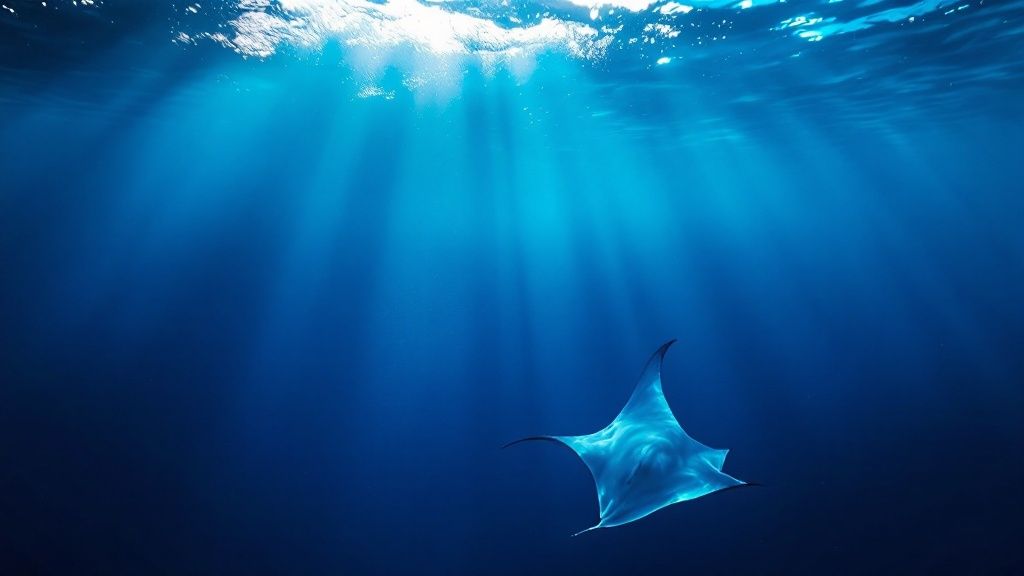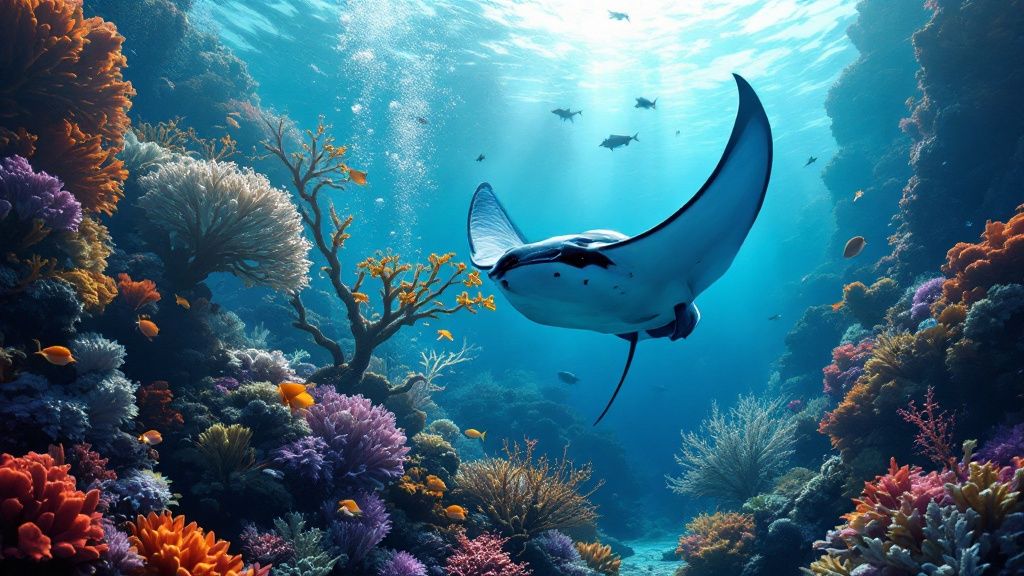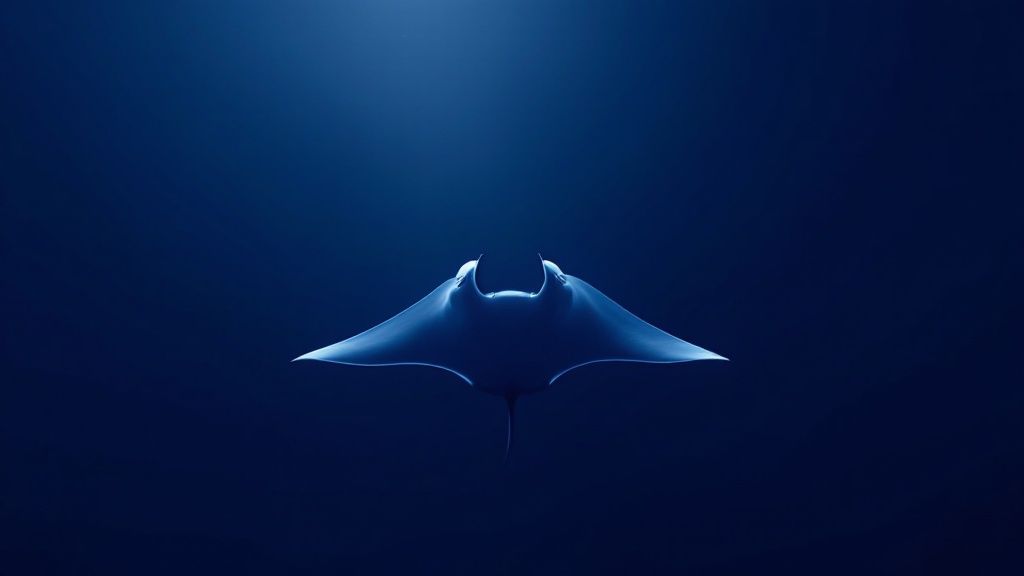Thrilling Kona Manta Ray Night Snorkel
- Byron
- Apr 12
- 11 min read
The Magic of Kona Manta Rays: Moonlit Underwater Ballet
Imagine floating in the dark depths of the Pacific, the moon casting an ethereal glow on the water's surface. Suddenly, massive, graceful shapes emerge from the deep: Kona manta rays. This isn't just another wildlife encounter; it's a captivating underwater ballet performed by some of the ocean's most graceful creatures. These gentle giants, with wingspans reaching up to 12 feet, glide effortlessly through the water. It's a truly unforgettable spectacle.
The Kona coast offers a unique and reliable environment for observing these magnificent animals. Marine biologists consider this area to have the most consistent manta ray viewing opportunities worldwide. This is due to a perfect combination of factors: the underwater topography, the abundance of plankton, and consistently favorable water temperatures. The experience is more than just visually appealing; it's profoundly moving. Many visitors describe a deep emotional connection with these gentle giants, from the initial awe of their size to the peaceful calm they inspire.
Why Kona is a Manta Ray Hotspot
The Kona coast of Hawaii's Big Island is famous for its high success rate of manta ray sightings. Over the years, data collection has shown an astounding 80-90% success rate for encountering these majestic creatures on night snorkeling tours. This consistency is due to the unique underwater formations. These formations create natural channels that funnel plankton, the manta ray's primary food source, into predictable feeding areas. Two popular spots are Manta Village and Manta Heaven.
Researchers have identified and cataloged over 300 individual manta rays in this area, each with unique markings. This allows for ongoing tracking and behavioral studies. This incredible phenomenon attracts approximately 80,000 visitors annually, boosting local tourism and raising awareness about these incredible animals. Learn more about the best time to see manta rays in Kona.
Choosing Your Kona Manta Ray Adventure
Several reputable tour operators offer unique experiences to get you up close with Kona manta rays. Some popular choices include Kona Honu Divers, Manta Ray Night Snorkel Hawaii, Kona Snorkel Trips, and Captain Cook Snorkeling Tours. These tours offer varying levels of intimacy and amenities, from small, personalized groups to larger excursions.
Choosing the right tour can greatly enhance your experience. You might be interested in: our sitemap for blog categories for more information.
Experiencing the magic of Kona manta rays is more than just sightseeing; it’s a chance to connect with nature on a deeper level. The graceful movements of these gentle giants, illuminated by the moonlight and underwater lights, create an unforgettable experience. This unique encounter showcases the beauty and wonder of the natural world. It's an experience that should be on every ocean lover's bucket list.

Prime Kona Manta Ray Viewing Spots: Insider's Guide
Kona, Hawaii, is a true manta ray haven. The volcanic coastline creates the perfect environment for these gentle giants, making Kona a world-renowned spot for manta ray encounters. But where are the best viewing locations? This guide reveals Kona's prime manta ray spots and what makes each unique.
Manta Village: A Close Encounter
Just off Keauhou Bay lies Manta Village, perhaps the most famous manta ray viewing spot in Kona. The shallow, sandy bottom creates an ideal stage for the manta ray's nightly feeding. Surrounding lava formations add to the dramatic backdrop of this natural spectacle. Here, you'll likely see mantas performing acrobatic barrel rolls as they feast on plankton, a truly mesmerizing sight.
Manta Heaven: A Deeper Dive
For a different experience, head north to Manta Heaven at Garden Eel Cove. Slightly deeper than Manta Village, this location offers a more immersive experience. Strong currents bring in rich plankton, attracting larger groups of manta rays. While slightly more challenging for new snorkelers, the rewards can be greater, with opportunities to witness multiple mantas feeding together.
Other Notable Viewing Spots
Beyond Manta Village and Manta Heaven, other locations provide unique perspectives on these magnificent creatures. Exploring areas along the Kohala Coast might reveal mantas in different environments. This shows the adaptability of Kona's manta rays and highlights the diverse underwater landscapes of the region. For more information, explore our blog post sitemap.

Manta rays in Kona have been studied extensively, with detailed sighting records from 2009-2014 compiled by Manta Ray Advocates Hawaii. This research revealed consistent patterns in manta ray behavior at key locations, confirming Kona's status as a premier manta ray destination with a 60-80% sighting chance during night dives at specific sites. More detailed statistics can be found here.
To help you choose the best spot, we've created a comparison table of the key viewing locations.
Kona Manta Ray Viewing Locations Comparison: This table compares the main manta ray viewing locations in Kona with key attributes for each site.
Location | Access Method | Average Depth | Best Time to Visit | Success Rate | Special Features |
|---|---|---|---|---|---|
Manta Village | Boat | Shallow | Night | High | Sandy bottom, lava formations |
Manta Heaven | Boat | Deeper | Night | High | Strong currents, larger groups |
Kohala Coast | Boat/Shore | Varies | Varies | Moderate | Diverse environments |
This table highlights the key differences between the main viewing locations. Manta Village is ideal for beginners due to its shallow depth, while Manta Heaven offers a more immersive experience for experienced snorkelers and divers. The Kohala Coast presents diverse environments and viewing opportunities.
Choosing the Right Spot for You
Each viewing spot has unique advantages. The best choice depends on your experience and what you're looking for.
Beginner Snorkelers: Manta Village offers calm, shallow waters.
Experienced Snorkelers/Divers: Manta Heaven provides a deeper experience with potential for larger manta gatherings.
Unique Experiences: Explore the Kohala Coast for a different perspective.
By understanding each site's characteristics, you can tailor your Kona manta ray experience to your needs. Seasonal patterns can also influence manta ray activity, so consulting local tour operators is essential for maximizing your chances of an unforgettable encounter. Whether you choose Manta Village or Manta Heaven, experiencing these gentle giants up close will be a memory you won't forget.
Planning Your Perfect Kona Manta Ray Adventure

Picking the right tour operator is key for an amazing Kona manta ray experience. It's about more than just flashy brochures; it's about understanding what truly makes a tour stand out. This guide will walk you through choosing the perfect operator and getting ready for your adventure.
Selecting the Right Tour Operator
From smaller, personalized boat tours to larger vessels, Kona has plenty of manta ray tour options. But what really separates the good from the great? Here are a few essential factors:
Group Size: Smaller groups often mean more one-on-one time with your guides and closer manta ray encounters.
Guide Experience: Experienced, knowledgeable guides who are passionate about manta rays and conservation can significantly enhance your trip. They'll share fascinating insights and ensure respectful interactions with the mantas.
Eco-Friendly Practices: Choose operators dedicated to sustainable tourism. Look for practices that minimize environmental impact and protect the manta rays' natural habitat.
Inclusions: Consider what's included in the tour price. This includes equipment like wetsuits, snorkel gear, and flotation devices. Some tours might offer extras like underwater photography or videography packages.
Reviews and Testimonials: Online reviews and testimonials offer valuable, unfiltered perspectives from past guests, giving you a better sense of the tour quality and operator professionalism.
To get you started, here's a quick comparison of some popular Kona manta ray tour operators:
Top Kona Manta Ray Tour Operators Detailed comparison of the leading manta ray snorkel tour providers in Kona with their offerings and unique features
Tour Company | Tour Duration | Group Size | Price Range | Equipment Provided | Special Features |
|---|---|---|---|---|---|
Varies | Small Groups | Check Website | Snorkel Gear, Wetsuits | Focus on Conservation | |
~2 hours | Small-Medium Groups | Check Website | Snorkel Gear, Flotation | Personalized Service | |
~2 hours | Varies | Check Website | Snorkel Gear, Wetsuits | Multiple Snorkel Sites | |
Varies | Varies | Check Website | Snorkel Gear | Daytime & Sunset Tours |
This table provides a starting point. Be sure to visit each operator's website for the most up-to-date details and to find the best fit for your needs.
Preparing for Your Adventure
A little pre-planning can greatly increase your chances of a truly magical manta ray encounter. You can find even more details on our sitemap for additional pages. Here's a checklist to ensure you're fully prepared:
Seasickness Prevention: If you're prone to seasickness, take necessary precautions. This could include talking to your doctor about medication, or using motion sickness wristbands.
Attire: Dress in layers. Even in warm Hawaiian waters, you might get cold after being in the water for a while. Don't forget a towel and a change of dry clothes.
Physical Readiness: While snorkeling isn't overly strenuous, a reasonable level of fitness is helpful. If you haven't snorkeled recently, practicing beforehand, especially if you have any anxiety about open water, is a good idea.
Gear: Bring your own snorkel gear if you have it for a personalized fit. If not, reputable operators will provide everything you need. An underwater camera or GoPro can help capture the experience, just remember to maintain a respectful distance.
Mental Preparation: Get ready for the unique experience of being in the ocean at night. Embracing the darkness enhances the magic of the manta rays. Talk to your guides about any concerns you might have.
Managing Expectations
While Kona has excellent manta ray sighting rates, remember these are wild animals in their natural environment. Sightings aren't guaranteed, but many reputable operators offer a "manta ray guarantee," providing a free repeat tour if you don't see any mantas.
Ocean conditions can also vary. Water clarity, currents, and weather can all affect your experience. Be flexible and enjoy the unexpected. The beauty of these encounters lies in their unpredictable nature.
By following these tips, you’ll be well on your way to a wonderful experience with Kona’s manta rays.
Your Kona Manta Ray Night Snorkel Experience Decoded

Your Kona manta ray night snorkel adventure begins the moment you step onto the harbor. Excitement builds as you meet your guides and fellow snorkelers. The crew extends a warm welcome, setting a positive tone for the unique journey ahead.
Preparing for the Encounter
Before entering the water, you'll participate in a comprehensive pre-dive briefing. This essential session covers snorkeling basics, ensuring you understand proper mask and snorkel usage, safe water entry techniques, and how to utilize provided flotation devices. Guides also discuss manta ray behavior and respectful observation etiquette, preparing you mentally and technically for the encounter.
The Illumination Technique
Once in the water, specialized lighting systems, deployed by the guides, attract plankton, the manta rays' primary food source. This creates a fascinating "plankton cascade," drawing the mantas closer to the surface. The illuminated water provides incredible visibility, allowing for remarkable up-close views of these graceful creatures as they feed. Decades of manta ray sighting records in Kona, beginning in 1991, have contributed significantly to research and data collection. Over 14 years, these records document over 28,500 sightings and almost 6,000 individual encounters, with over 330 identified mantas. This wealth of information is invaluable for understanding manta ray behavior and population dynamics. Learn more at Manta Pacific Research Foundation.
Witnessing the Manta Ballet
Suspended in the dark ocean, surrounded by glowing plankton, with massive manta rays gliding just inches away, is a truly awe-inspiring experience. You might witness barrel rolling, a feeding behavior involving manta ray somersaults to maximize plankton consumption. Alternatively, observe chain feeding, where multiple mantas synchronize their efforts, lining up to filter plankton in a coordinated fashion. Your guides will provide expert insights into these behaviors, enriching your understanding and appreciation of the Kona manta ray.
Addressing Comfort and Safety
Each Kona manta ray snorkel experience is unique, varying slightly based on ocean conditions and the operator's approach. While some nights offer calmer waters, reputable operators prioritize guest comfort and safety, adapting procedures to suit the environment. Several respected operators include Kona Honu Divers, Manta Ray Night Snorkel Hawaii, Kona Snorkel Trips, and Captain Cook Snorkeling Tours. These companies might offer various flotation aids for less confident swimmers or extra guidance in choppier conditions, ensuring a positive experience for everyone, regardless of experience level.
Protecting Kona's Magnificent Manta Rays
Experiencing Kona's manta rays is more than just a tourist attraction. It's a chance to connect with these gentle giants and contribute to vital conservation work. Protecting these creatures and their habitat is a key part of the Kona manta ray story.
Tourism as a Conservation Tool
Tourism, sometimes seen as an environmental threat, has become an unexpected partner in manta ray conservation. Tour operators have become passionate advocates, educating visitors about the importance of protecting these magnificent animals.
Many operators now emphasize eco-friendly practices. For example, some encourage the use of reef-safe sunscreen and minimize plastic waste on their tours. This shift from business to environmental stewardship inspires visitors to become lifelong manta ray conservation supporters.
Furthermore, citizen science initiatives engage visitors in conservation. Tourists can photograph individual manta rays for identification, contributing to research databases. This helps track manta populations and understand their behavior, strengthening the link between tourism and conservation. For more information, you can explore our blog category sitemap.
Technological Advancements in Manta Ray Protection
Technology plays a crucial role in understanding and safeguarding Kona's manta rays. Underwater acoustic networks track manta movements, revealing migration patterns and habitat use. Photo identification systems recognize individual mantas based on their unique spot patterns, aiding long-term population studies.
This technology provides essential data for scientists and conservationists. The data collected over time underscores Kona's significance as a critical manta ray habitat.
Challenges and Collaborative Efforts
Despite increased awareness, Kona's manta rays face challenges. Climate change affects plankton populations, a primary food source for mantas, potentially impacting their feeding habits and health. Microplastic pollution is another concern, as mantas may ingest these particles.
However, collaborative efforts offer hope. Scientists, tour operators, and government agencies are working together to implement sustainable tourism practices, enforce habitat protection regulations, and raise public awareness.
Manta Ray Conservation: A Shared Responsibility
Protecting Kona's manta rays is a collective effort. We can all contribute by supporting responsible tour operators, participating in citizen science projects, and making environmentally conscious decisions.
Continued collaboration and technological advancements deepen our understanding of these gentle giants, reinforcing our commitment to their survival. The magic of Kona's manta rays is a treasure worth preserving. By working together, we can ensure these encounters continue to inspire awe for generations to come.
Capturing Breathtaking Kona Manta Ray Moments
Want to keep the magic of your Kona manta ray experience alive? Transform those incredible moments into stunning photos and videos. This section offers helpful tips and tricks for capturing breathtaking underwater imagery, even with basic equipment.
Mastering Night Water Photography
Taking photos at night while snorkeling presents unique challenges. The darkness and artificial lights require some adjustments to your usual camera settings. Here's how to get dramatic images of Kona manta rays.
Shutter Speed: A faster shutter speed will freeze the manta rays' movement and prevent blur caused by the reflecting light.
Aperture: A wide aperture (represented by a low f-stop number) is key. It lets in more light, essential in dark conditions, and helps isolate the manta ray against the background.
ISO: Increasing the ISO makes your camera more sensitive to light. But be careful! Too high, and you'll get grainy images. Experiment to find the sweet spot.
Focus: Autofocus can be tricky in low light. Try pre-focusing manually on the area where the mantas are feeding.
Ethics of Wildlife Photography
Getting amazing photos should never come at the expense of the manta rays' well-being. Respectful photography means keeping a safe distance and prioritizing the animals' natural behavior.
Respectful Distance: Maintain a safe distance to avoid disrupting the mantas' feeding or causing them stress.
Flash Considerations: Avoid flash photography. It can disorient and frighten the manta rays. Stick to available light and adjust your camera settings accordingly.
Prioritize Animal Welfare: Observe the mantas without interfering. Never chase them or attempt to touch them. Learn more about ethical wildlife photography in our article: How To Ethically Photograph Wildlife.
Post-Processing Techniques
A few simple edits can dramatically improve your underwater photos. Here's how to enhance your images while keeping them authentic.
Color Correction: Water distorts colors, often making images appear too blue or green. Adjust the white balance to restore natural tones.
Cropping and Composition: Crop your photos to improve composition and highlight the manta rays. This can also help eliminate distractions.
Sharpening and Contrast: Subtle sharpening and contrast adjustments can bring out detail and texture.
Your photos can also contribute to citizen science. Sharing your images with researchers can help track individual manta rays and support conservation efforts.
Equipment Recommendations
You don't need expensive equipment to capture great manta ray photos. Here are a few options for different budgets:
GoPro: Action cameras like GoPro are compact, durable, and waterproof – perfect for underwater photography.
Underwater Housings: Protect your standard camera underwater with a waterproof housing.
Compact Underwater Cameras: These dedicated cameras provide good image quality in a user-friendly format.
By understanding night water photography, respecting the mantas, and using simple editing techniques, you can create lasting memories of your Kona manta ray adventure. You'll not only capture beautiful images, but also contribute to the appreciation and protection of these amazing creatures.
Ready for an unforgettable experience? Book your Manta Ray Night Snorkel Kona Hawaii Tour today!
Comments